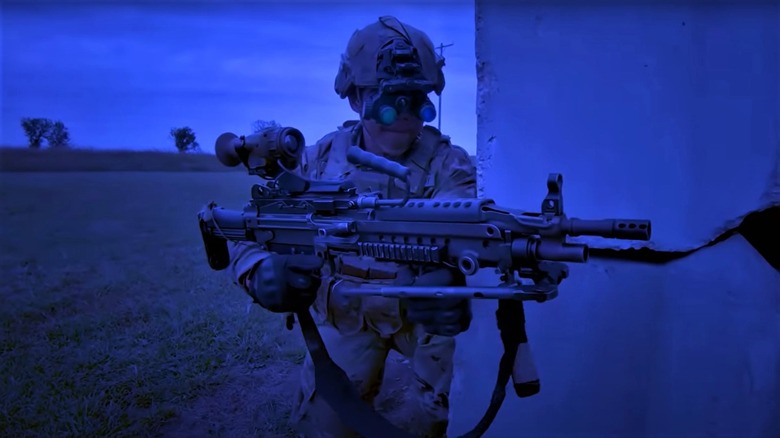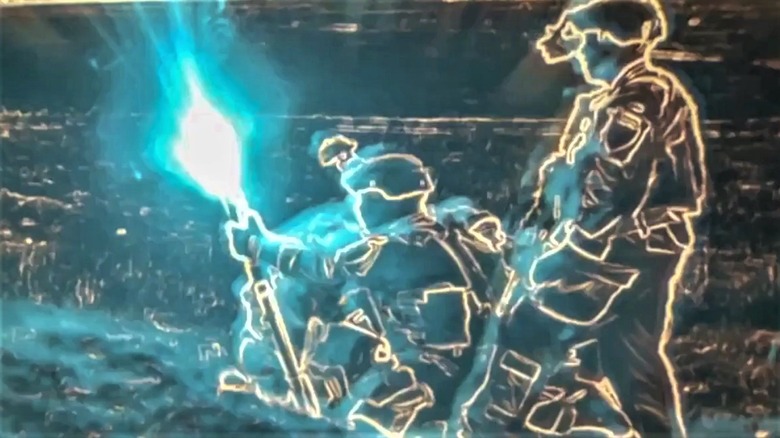These US Army Night Vision Goggles Give You Futuristic Predator Like Vision
The U.S. Army's most advanced night vision goggles look like tech fit for a Predator; but just how effective is it compared to its sci-fi counterpart? In 2021, the United States military showcased the capabilities of its advanced optics system. Dubbed the Enhanced Night Vision Goggle-Binocular (ENVG-B), these high-tech goggles can not only see in complete darkness. They also highlight potential targets using colorful outlines. In the "Predator" films, the franchise's eponymous antagonist utilizes a similar optical system embedded in its mask. This vision augmentation featured in the film allows the extraterrestrial to cycle through various filters that highlight different objects. These potential targets, be they prey or a potential threat, stood out dramatically depending on the Predator's chosen vision filter — the visuals here were an enormous highlight of the original film.
With the help of the ENVG-B, the U.S. Army now has something similar at its disposal, except these goggles only use a single filter that shows everything, foregoing the need of having to cycle through various modes in the process. In the movies, Predators relied on heat signatures to determine their prey's location, and this is something the ENVG-B also leans on heavily. In a tweet, the U.S. Army teased this capability by highlighting gunfire and human bodies in contrasting, easily discriminable hues. Although scientists are still in the midst of developing night vision eye drops, the most advanced night vision goggles are already here, and ready for action. But how will they fare in an actual life-and-death scenario?
How does the most advanced night vision technology work?
Fans of the iconic "Predator" franchise always wonder how effective Predator vision would be for humans; the ENVG-B's unique characteristics put a face to that exact question. In fact, the U.S. has already placed orders totaling $107 million to equip soldiers with ENVG-B units, according to the supplier, Elbit Systems of America. Over 1,500 of these high-tech goggles have been delivered to the military's 10th Mountain Division courtesy of L3Harris Technologies. Needless to say, the U.S. Army is putting a lot of faith (and money) into these ENVG-Bs. But how well do they perform, and do they warrant such a sizable investment? A YouTube video by L3Harris showcased a lot of the cutting-edge features underpinning what it deems as the "most advanced night fighting system."
Among the ENVG-B's benefits include drastically increasing a soldier's situational awareness in all conditions, allowing them to see through smoke, fog, or areas with generally poor visibility. While it doesn't visibly triangulate targets akin to the Predator's automated targeting system, these advanced tech goggles do showcase what's called "rapid target acquisition." This lets soldiers integrate their ENVG-B goggles with their weapon sights, allowing them to shoot behind cover without having to stick their heads out. Elbit Systems' ENVG-Bs are also capable of differentiating friend from foe, which is crucial on the battlefield. Utilizing augmented reality combined with improved visuals, thermal imaging, and night vision, builders have certainly delivered on the promise to create the most advanced night vision technology America's military has ever deployed.
Rise of the advanced night vision goggles tech
As the U.S. Army outfits soldiers with its most advanced night vision system, similar tech goggles seem to be surfacing elsewhere, too. This video showcases a thermal fusion night vision device from an exhibit at the 2022 Zhuhai Air Show in China. It features a familiar Predator-like filter, outlining people in view. Another tweet highlighted how these night vision goggles perform in real time, seamlessly separating people from background objects in an instant. So, will the rest of the world get a chance to use functional tech goggles with Predator vision too? ENVG-Bs might not be designed for civilian use, but that doesn't mean consumers don't have access to at least some of their benefits. Companies like Teledyne FLIR manufacture night vision thermal lenses for a variety of applications. From security cameras to vehicle dashcams, the FLIR system allows average people to segregate living objects from obstacles in total darkness.
InfiRay is another tech firm producing consumer-grade thermal infrared imaging, including tiny modules that can easily integrate with smartphones (via InfiRay). While these solutions might not be as sophisticated, or directly combat-oriented, as in the U.S. Army's build, their diverse functionality can still aid civilians while identifying and avoiding threats wherever visibility is limited. Indeed, a proliferation of thermal night vision applications in consumer devices is ongoing: USC notes that these same infrared technologies are starting to make headway in consumer vehicle safety features and beyond.

